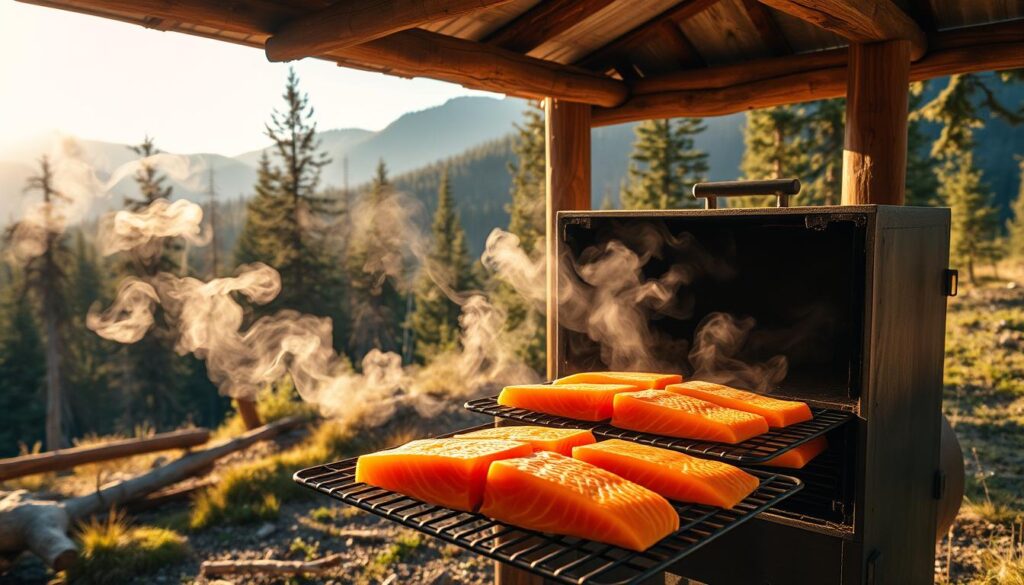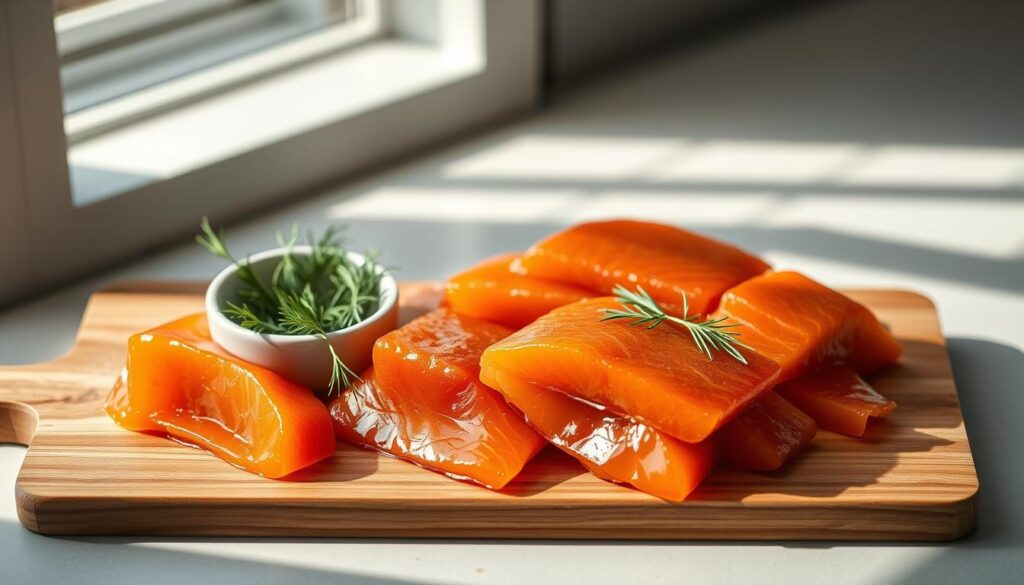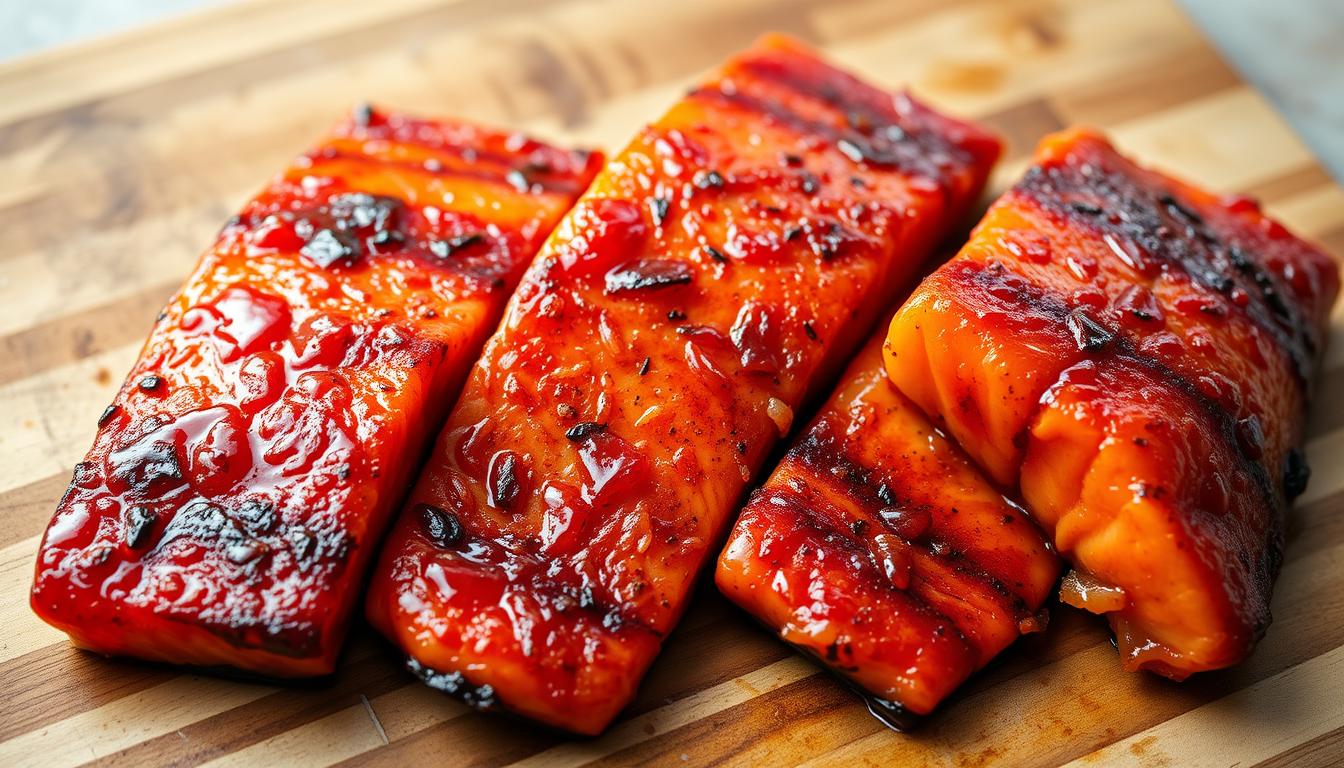Delicious Candied Salmon Recipe
The first time I tasted candied salmon, it was a culinary discovery. The sweet and smoky salmon melted in my mouth. It changed how I saw seafood forever. Growing up in the Pacific Northwest, I learned this dish is more than food. It’s a celebration of tradition, flavor, and skill.
If you’ve never tried candied salmon, get ready for a tasty adventure. This Pacific Northwest favorite mixes rich salmon with sweet and smoky flavors. It will wow your taste buds.
Whether you’re an experienced cook or just starting, this recipe will take you on a memorable seafood journey. It connects you to generations of cooking wisdom.
Table of Contents
Understanding Candied Salmon: A Pacific Northwest Tradition
Pacific Northwest salmon is more than a tasty dish. It’s a cultural treasure tied to indigenous traditions and local food. Making candied salmon has changed from a survival skill to a beloved dish that brings families together.
The story of candied salmon shows the cleverness of coastal people. They created ways to keep food safe when it was hard to find. Today, these old ways mix with new cooking ideas.
Origin and Cultural Significance
Indigenous groups along the Pacific Northwest coast started preserving salmon. Their methods were not just for keeping food. They were also about their spiritual bond with salmon, seen as a vital resource.
- Salmon was key in their ceremonies
- They shared preservation secrets through generations
- Fishing and smoking were community efforts
Traditional vs Modern Preparation Methods
Old ways of making salmon involved long cold-smoking times. Now, quicker methods make candied salmon easier for home cooks to make.
| Traditional Method | Modern Method |
|---|---|
| Cold smoking (3-5 days) | Hot smoking (2-4 hours) |
| Natural wood fires | Electric or gas smokers |
| Hand-crafted smoking racks | Standardized smoking equipment |
Health Benefits of Salmon
Salmon is not just tasty; it’s also very good for you. It’s packed with nutrients that help keep you healthy.
- Rich in omega-3 fatty acids
- Good source of protein
- Full of vitamins and minerals
- Good for your heart and brain
Learning about the cultural value and health perks of Pacific Northwest salmon makes you value this tradition even more. It’s not just about the flavor.
Essential Ingredients for Perfect Candied Salmon
Starting to make candied salmon is all about picking the right ingredients. You’ll need fresh, top-quality salmon fillets. These will turn into a dish that’s both delicious and special.
To make candied salmon truly stand out, you need the right mix of ingredients. Here’s what you’ll need to make this Pacific Northwest favorite:
- Fresh salmon fillets (preferably wild-caught)
- Kosher salt for curing
- Brown sugar
- Pure maple syrup for salmon glazing
- Black pepper
- Optional spices (paprika, garlic powder)
Maple syrup is more than just sweetener for salmon. It’s a key flavor booster. Use 100% pure maple syrup for a deep, rich taste. This makes your candied salmon go from good to amazing.
The natural sugars in maple syrup make the salmon golden and moist. This is what gives it a beautiful caramelized look.
When picking your ingredients, choose the best. Wild-caught salmon tastes better than farmed. Also, pick grade A or B maple syrup for the strongest flavor.
Pro tip: Local farmers markets have the freshest salmon and best maple syrup. This gives you the best ingredients for your dish.
Selecting and Preparing Your Salmon
Making the perfect candied salmon starts with picking the right fish. It also means knowing how to prepare the salmon fillet. The type of salmon you choose will greatly affect the taste and texture of your dish.
When picking salmon, look for freshness and quality. Wild-caught Pacific salmon, like Sockeye or King, has the best flavors for candying.
Choosing the Right Cut
For the best results, choose skin-on salmon pieces that are:
- Fresh and vibrant in color
- Firm to the touch
- Free from strong fishy odors
- Cut into 1- to 2-inch thick strips
Mastering Deboning Salmon
Deboning salmon needs care and patience. Here’s how to do it right:
- Lay the salmon on a clean cutting board
- Run your fingers along the center of the fillet to feel for pin bones
- Use clean fish tweezers to carefully remove each bone
- Pull bones at a slight angle to minimize flesh damage
Preparing for Brining
After deboning, rinse the fillet under cold water and pat dry with paper towels. Your salmon is now ready for brining. This step adds amazing flavor and texture.
| Salmon Type | Best For Candying | Flavor Profile |
|---|---|---|
| Sockeye | Excellent | Rich, deep flavor |
| King | Outstanding | Buttery, smooth texture |
| Coho | Good | Mild, delicate taste |
The Art of Brining Your Salmon
The salmon brining process is key to making delicious candied salmon. Dry brining turns an ordinary fish into a flavorful treat. It keeps the salmon moist and enhances its taste.
To start your salmon brining, you’ll need a few ingredients:
- Kosher salt
- Brown sugar
- Fresh salmon fillet
- Optional spices (black pepper, garlic powder)
Here’s how to dry brine your salmon:
- Mix equal parts salt and brown sugar in a bowl
- Pat the salmon dry with paper towels
- Coat the salmon with the salt-sugar mixture
- Put the salmon in a non-reactive dish
- Refrigerate for 4-12 hours
The salmon brining process is amazing. It pulls out moisture and adds flavor. Salt is a powerful preservative and seasoning. It makes your salmon moist and tasty during smoking.
Pro tip: Use fresh, quality salmon for the best taste. Adjust brining time based on fillet thickness to avoid over-salting.
Creating the Perfect Maple Syrup Glaze
Making a great maple syrup glaze is key to turning simple salmon into a fancy dish. The right glaze can make your salmon go from good to amazing. It adds sweet flavors that match the fish’s taste.
The quality of your maple syrup is very important when glazing salmon. Use pure, Grade A maple syrup for the best flavor.
Essential Glaze Ingredients
- Pure maple syrup (preferably dark amber)
- Coarse sea salt
- Freshly ground black pepper
- Apple cider vinegar
- Optional: red pepper flakes for heat
Maple Syrup Glaze Application Techniques
Getting the maple syrup glaze right takes skill and patience. It’s important to apply the glaze strategically while smoking. Brush the glaze on every 40 minutes for even coverage.
- Start with a thin layer of maple syrup glaze
- Use a silicone brush for smooth application
- Avoid over-glazing to prevent burning
- Let each layer caramelize slightly before adding the next
Your aim is to get a shiny, moist exterior. This adds a sweet-savory taste to the fish.
Smoking Techniques for Candied Salmon

Learning to smoke salmon is key to making delicious candied salmon. The right techniques can turn a simple fish into a gourmet dish. Start by picking the best equipment and learning about temperature control.
When smoking salmon, focus on a few important techniques:
- Choose a high-quality smoker with precise temperature settings
- Select wood chips that complement salmon’s delicate flavor
- Maintain consistent smoke levels throughout the process
Temperature is very important when smoking salmon. Experts say to keep temperatures between 120°F to 200°F. Lower temperatures make the salmon tender and flavorful. Smoke the fish for 3-6 hours, depending on its thickness and your preference.
Choosing the right wood chips can change the salmon’s taste. Apple or alder wood gives a sweet flavor that goes well with maple glaze. Try different woods to find your favorite.
Pro tip: Use a digital meat thermometer to check the salmon’s internal temperature. This helps you cook it to perfection without overcooking.
Tips for Achieving the Perfect Texture
Getting the right texture for candied salmon takes skill and focus. It’s all about knowing how temperature and cooking time work together. This will help you get the perfect doneness.
The texture of candied salmon can be very moist or chewy, depending on how you cook it. Learning to control these factors will make your salmon turn out great every time.
Navigating Temperature Control
Temperature is key for the right salmon texture. Here are some tips for keeping the heat just right:
- Keep smoker temperature between 165-185°F
- Avoid rapid temperature fluctuations
- Use a digital thermometer for precise monitoring
Determining Candied Salmon Doneness
Figuring out when your salmon is done needs careful watching and testing. Here’s how to check:
| Texture | Visual Cues | Recommended Cooking Time |
|---|---|---|
| Moist and Tender | Glossy, slightly translucent | 2-3 hours |
| Firm and Chewy | Opaque, darker color | 3-4 hours |
Your taste preferences will guide your candied salmon’s doneness. Try different cooking times to find your favorite texture. Remember, practice makes perfect!
Storage and Serving Suggestions

Storing candied salmon right lets you enjoy it for days or weeks. Keeping it fresh is all about the right storage.
There are a few ways to keep your candied salmon tasty and fresh:
- Refrigeration: Store it in an airtight container in the fridge for up to 7 days
- Vacuum sealing: Keep it fresh for 2-3 weeks with a vacuum sealer
- Freezing: Freeze it for up to 3 months for long-term storage
Serving candied salmon opens up a world of flavors. It’s perfect for many dishes with its sweet and smoky taste:
- Appetizer platters with cream cheese and crackers
- Salad topping for extra protein and flavor
- Elegant brunch centerpiece
- Gourmet pizza or flatbread ingredient
When serving candied salmon, pair it with flavors like dill, citrus, or crisp white wine. Let it sit at room temperature for 10-15 minutes before serving. This will make it taste better and feel softer.
Conclusion
Making homemade candied salmon is more than a recipe. It’s an art that connects you to the Pacific Northwest’s culinary traditions. You start by picking the best salmon, then brine it perfectly. After that, you create a sweet maple glaze.
As you try out different salmon recipes, remember each batch is a chance to get better. You can tweak the sweetness and smokiness to your liking. Feel free to try new wood chips, change smoking times, or try different glazes to make your salmon special.
This dish is great for any occasion or a simple meal. It’s perfect as an appetizer, in salads, or as a protein-rich snack. Your homemade candied salmon will wow everyone. Trust your cooking skills and enjoy the tasty outcome.
Your journey with candied salmon is just starting. Share your dishes, learn from each one, and keep exploring this beloved Pacific Northwest treat.
FAQ
What is candied salmon?
What type of salmon works best for candying?
How long does candied salmon last?
Is candied salmon healthy?
Can I make candied salmon without a smoker?
What wood chips are best for smoking salmon?
How do I prevent my candied salmon from becoming too dry?
What can I serve with candied salmon?
Is real maple syrup necessary for the glaze?
Can I make candied salmon with different types of fish?
There are no reviews yet. Be the first one to write one.

